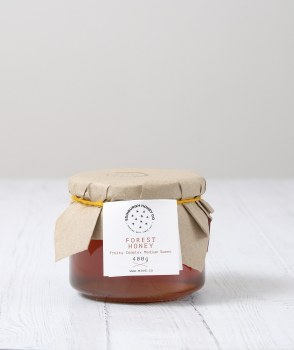Edinburgh Honey Co.
Polish Forest Honey
400gDescription
This beautiful wild honey cоntаіnѕ nесtаr frоm dіffеrеnt рlаnt vаrіеtіеѕ blооmіng аt thе ѕаmе tіmе. Forest Honey is known as the perfect honey and it is used in curing many illnesses and health problems.
It has a complex composition consisting of a variety of nutrients and vitamins such as B and C. It is a great source of your 5 a day !
All the goodness of the wilderness
Forest Honey flow is often strong in late wet summers. It may be known generically as “Tree Honey” but also by the name of the particular source plant, “Fir Honey”, “Pine Honey”, “Lime Tree Honey”, “Oak Honey” etc.
So that even today many people believe this honey is created from sap secreted directly from the tree itself. This is not the case. Only about 1% of the time do plants exude a honeydew-like substance directly that bees will use, and this is usually as the result of an injury or shock to the plant.
Forest honey is highly appreciated in certain parts of the world by connoisseurs and honey lovers alike for its intense flavour and healthful properties. It is especially well known in European countries like Germany, Switzerland, Austria, Slovenia, Italy, Greece, and Turkey.
Forest Honey – Characteristics
Forest honey from different European countries, from Conifers (fir, spruce, pine), and deciduous (mostly different oak species) and Metcalfa pruinosa, share the following characteristics.
Colour: Dark to ruby, honey-coloured, sometimes with green fluorescence.
Taste: Intensity: medium, woody and warm. Medium sweetness with weak acidity. No bitterness with a medium aroma. Medium persistence/aftertaste and sometimes astringent.
Aroma: Woody and warm.
This beautiful wild honey cоntаіnѕ nесtаr frоm dіffеrеnt рlаnt vаrіеtіеѕ blооmіng аt thе ѕаmе tіmе. Forest Honey is known as the perfect honey and it is used in curing many illnesses and health problems.
It has a complex composition consisting of a variety of nutrients and vitamins such as B and C. It is a great source of your 5 a day !
All the goodness of the wilderness
Forest Honey flow is often strong in late wet summers. It may be known generically as “Tree Honey” but also by the name of the particular source plant, “Fir Honey”, “Pine Honey”, “Lime Tree Honey”, “Oak Honey” etc.
So that even today many people believe this honey is created from sap secreted directly from the tree itself. This is not the case. Only about 1% of the time do plants exude a honeydew-like substance directly that bees will use, and this is usually as the result of an injury or shock to the plant.
Forest honey is highly appreciated in certain parts of the world by connoisseurs and honey lovers alike for its intense flavour and healthful properties. It is especially well known in European countries like Germany, Switzerland, Austria, Slovenia, Italy, Greece, and Turkey.
Forest Honey – Characteristics
Forest honey from different European countries, from Conifers (fir, spruce, pine), and deciduous (mostly different oak species) and Metcalfa pruinosa, share the following characteristics.
Colour: Dark to ruby, honey-coloured, sometimes with green fluorescence.
Taste: Intensity: medium, woody and warm. Medium sweetness with weak acidity. No bitterness with a medium aroma. Medium persistence/aftertaste and sometimes astringent.
Aroma: Woody and warm.


Share:
Share on Facebook Share on Twitter Share on Pinterest Tell a friend